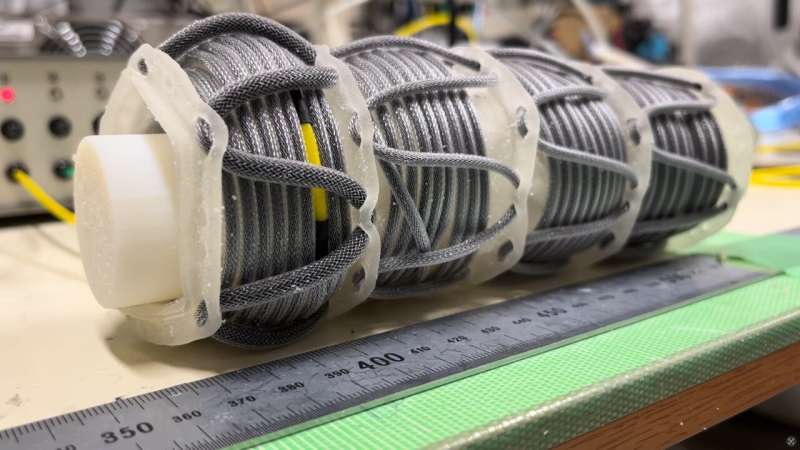February 23, 2024 feature
This article has been reviewed according to Science X's editorial process and policies. Editors have highlighted the following attributes while ensuring the content's credibility:
fact-checked
trusted source
proofread
An inchworm-inspired robot with enhanced transport capabilities

Soft robots inspired by animals can help to tackle real-world problems in efficient and innovative ways. Roboticists have been working to continuously broaden and improve these robots' capabilities, as this could open new avenues for the automation of tasks in various settings.
Researchers at Nagoya University and Tokyo Institute of Technology recently introduced a soft robot inspired by inchworms that can carry loads of more than 100 g at a speed of approximately 9 mm per second. This robot, introduced in Biomimetic Intelligence and Robotics, could be used to transport objects and place them in precise locations.
"Previous research in the field provided foundational insights but also highlighted limitations, such as the slow transportation speeds and low load capacities of inchworm-inspired robots," Yanhong Peng told Tech Xplore. "For example, existing models demonstrated capabilities for transporting objects at speeds significantly lower than the 8.54 mm/s achieved in this study, with limited ability to handle loads above 40 grams."
The inchworm-inspired robot designs introduced so far leverage various actuation mechanisms, including dielectric elastomer actuators, shape memory alloys and soft pneumatic actuators. While these mechanisms can effectively reproduce the movements of inchworms, they often limit the speed and load capacity of robots.
"This paper emerged from the intersection of soft robotics and biomimicry, particularly inspired by the movement mechanisms of inchworms," Peng said. "Prior research efforts in soft robotics have explored various actuation methods (pneumatic, phototropic, and electrohydrodynamic) and materials (fabrics, resins, polymer gels) to mimic the adaptability and multifunctionality of biological organisms. These efforts have aimed to overcome the limitations of traditional rigid robots, such as their lack of flexibility and inability to handle delicate tasks."
As part of their recent study, Peng and his colleagues set out to develop a new inchworm-inspired robotic system with enhanced transport capabilities. To do this, they explored how different parameters, such as the number of activated body sections, the size and materials of objects carried, the air pressure supply, and the command execution rate, impacted their robot's performance.
"The inchworm-inspired robot mimics the unique 'Ω'-shaped movement of an inchworm by alternately contracting and extending its body, using McKibben artificial muscles for propulsion," Peng explained. "This design allows for efficient object transport over various surfaces, achieving high speeds and load capacities while maintaining the adaptability and simplicity characteristic of soft robotics."
The researchers created a prototype of their robot and tested it in a series of controlled experiments within a laboratory setting. Their results were highly promising, as the robot was found to outperformed other previously introduced inchworm-inspired robots both in terms of speed and load capacity.
"Our inchworm-inspired robot can transport objects at a maximum speed of 8.54 mm/s and handling loads exceeding 100 grams, significantly surpassing previous models in speed and load capacity," Peng said. "This advancement not only demonstrates the potential of biomimetic designs in robotics for improving efficiency and adaptability in transport tasks but also opens new avenues for practical applications in delicate object transportation and automated logistics."
The new robot created by this team of researchers could soon be introduced and evaluated in real-world settings, to validate its ability to transport objects with high speed. Meanwhile, Peng and his colleagues will try to further improve their system using deep learning techniques and other state-of-the-art computational models.
"In the future, we plan to integrate deep learning techniques and large language models to enhance the control and adaptability of inchworm-inspired robots," Peng added. "By leveraging deep learning algorithms, these robots could learn to autonomously adjust their movement strategies based on environmental conditions and object characteristics, improving their performance in complex, real-world scenarios.
"Additionally, large language models could facilitate natural language communication with the robots, enabling intuitive and user-friendly interaction for a wider range of applications."
More information: Yanhong Peng et al, Controlling a peristaltic robot inspired by inchworms, Biomimetic Intelligence and Robotics (2024). DOI: 10.1016/j.birob.2024.100146
© 2024 Science X Network



















